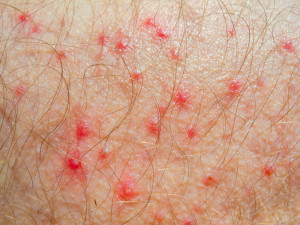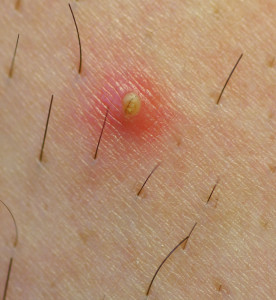Introduction
Folliculitis, furuncles, carbuncles and abscesses are all discussed here.
Folliculitis
If a skin infection affects a group of hair follicles, this is called a folliculitis. However, when the infection spreads and involves the tissue around the hair follicle as well, physicians call this a furuncle. In males the back of the neck is an area where furuncles like to occur and if several of them connect subcutaneously, this is called a carbuncle.
Furuncles and carbuncles
Occasionally, when these other conditions are not treated adequately, a skin abscess might form. This occurs particularly when some of the subcutaneous tissue melted away and formed a pus pocket. Diabetes predisposes to carbuncles. They tend to develop slower (several days) and they dissolve very slowly (often weeks) leaving behind a lot of scarring with defects (dimples) in the skin.
Folliculitis, furuncles and carbuncles are commonly due to Staphylococcus aureus. This is a bacterium, which grows on agar plates in the laboratory as golden yellow spots. It is from this appearance in culture that this bacterium got its name “aureus” (=golden).
Abscess
With a penetrating wound from a gunshot injury, knife injuries etc. bacteria from the skin or from the penetrating object get into the wound and multiply within a short time.
There is a limited time of 4 to 6 hours that the physician has to clean up and close such a wound. If this time frame is surpassed or if inadvertently pathological bacteria are left behind, an abscess will form. This is an accumulation of pus under pressure. The danger is that the bacteria spread via the lymphatic and blood vessels into the general circulation and into other vital organs. Staphylococcal sepsis, pneumonia, septic arthritis, osteomyelitis as well as endocarditis can subsequently develop. All of these conditions can be life threatening. Prompt recognition, accurate diagnosis and swift treatment (see below) will save many lives.
Signs and symptoms
Folliculitis presents with a pustule or reddish inflammation around a hair follicle.
There may be several spots of folliculitis. As the bacteria (mostly Staph. aureus) multiply quickly, sometimes the spreading of the infection can be a problem, particularly when infections develop in the skin under a beard. Furuncles are acute localized reddish nodules, which are painful, and tend to occur in the neck area, the face, on breasts and buttocks. Often it starts as a pus blister (pustule), which then breaks open and discharges pus and necrotic tissue. If furuncles occur at the nose or the ears they are particularly painful.
Carbuncles are larger and deeper than furuncles. They occur in the same areas as furuncles and also tend to break open. Abscesses present as tender, swollen areas of with red skin, which is hot and tender to touch. The patient often develops a fever as toxins circulate in the system. If pus migrates through the circulatory system, new abscesses form in other organs. With a brain abscess there are signs of a stroke (hemiplegia, with a paralysis of half of the body). When there are abscesses in other organs the patient develops symptoms in these organs.
Diagnostic tests
The diagnosis is mostly a clinical one. In other words, the symptoms and the history will allow the physician to come to the diagnosis with a high accuracy. When a person develops a skin abscess blood tests, blood cultures and some other tests may is necessary to help with the diagnosis. With deeper abscesses the physician orders such tests as ultrasound, CT scan and Gallium bone scan. The blood work usually shows a marked increase of the white blood cell counts (leukocytosis).
Treatment
For folliculitis the patient applies mupirocin ointment (brandname: Bactroban ointment) 3 to 4 times per day to the affected skin. The physician also orders oral administration of cloxacillin or cephalexin for 7 to 10 days to interrupt the cycle of reinfection.
Furuncles and carbuncles require treatment by incision and drainage. Isotretinoin (brand name: Accutane) is useful in severe acne cases where furuncles frequently occur. In the case of folliculitis the physician frequently orders oral antibiotics for longer periods of time.
A deep skin abscess needs incision and drainage by a surgeon. In a large abscess the physician inserts gauze packing or a surgical drainage tube to allow the wound to heal by “secondary” wound healing (“primary” is direct closure). Antibiotic coverage as above is given at the same time. The physician has to monitor intermittent blood tests and the clinical condition for possible complications. (Ref. 3, p. 799 and Ref. 2, p. 460).
References
1.The Merck Manual, 7th edition, by M. H. Beers et al., Whitehouse Station, N.J., 1999. Chapter 265.
2.James Chin et al., Editors: Control of Communicable Diseases Manual, 17th edition, 2000, American Public Health Association
3.The Merck Manual, 7th edition, by M. H. Beers et al., Whitehouse Station, N.J., 1999. Chapter 112.
4. The Merck Manual, 7th edition, by M. H. Beers et al., Whitehouse Station, N.J., 1999. Chapter 115.
5. The Merck Manual, 7th edition, by M. H. Beers et al., Whitehouse Station, N.J., 1999. Chapter 113.
6. Suzanne Somers: “Breakthrough” Eight Steps to Wellness– Life-altering Secrets from Today’s Cutting-edge Doctors”, Crown Publishers, 2008








